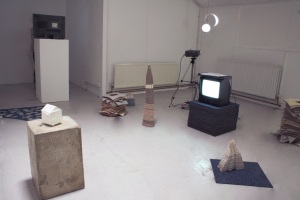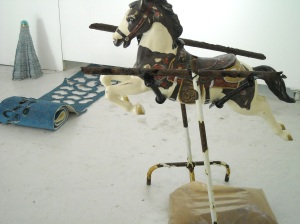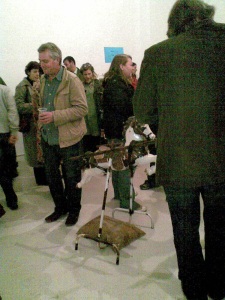Resampling artist Lorenza Ippolito in conversation with writer Tom Slingsby.
Tom Slingsby: What for you would be the perfect object and what would it do?
Lorenza Ippolito: I don’t know. I don’t think there is the perfect object. If there was a perfect object it would become quite boring.
TS: You’d have to stop hunting?
LI: Yeah, and it would be the end of the line I suppose. The good thing is that people change & so the meaning of objects changes.
TS: I suppose one of the interesting things about your project is that your objects are the prophets of their own demise. Even having the latest thing implies that that object is just waiting to be overtaken by something else. They all have a built-in death date don’t they? Do you think that the theme of resampling should celebrate capitalism or do think that the objects we’re producing in this project have in some way to resist commodification?
LI: I think it’s more an allegory of the situation.. obviously we’re in a capitalist system and its failing would mean the world as we know it would come to end and something else would come, and it’s not gonna be very soon..
TS: if ever!
LI: if ever! And so I’d like to think that my work provides anecdotes about the world we live in.
TS: As I’m imagining your project, it seems like there’s gonna be a very interesting tension between the personal and the impersonal because on the one hand they are things which are housed very close to the body, and on the other you’re detaching them from that context and focussing on how the endless procession of objects challenges their uniqueness.
LI: I think also my choice of mass-produced objects has the aspect of dialogue about it … and there’s also quite a lot of irony because it’s as if I’ve turned that object into a personal object by giving it an aura, even though they’re not really precious objects, are they? There was a series of quotes and one of them was from Austerlitz by W. G. Sebald, and it was really intense for me and I read it over and over again was about the world being full of objects that were indifferent. All these objects would never be able to hold the memory of the people who had been there and passed over them. Everything would be squashed into oblivion.
TS: So the objects express a lack of human presence?
LI: And also the dichotomy that so much is attributed to the object by human beings, memory is sort of stored by them; but at the same time, once the human that gave importance to the object is gone, nothing remains of the human being; everything that gave importance to the object dissolves into oblivion. And that really struck me and it gave me the idea of you know why not interview the object as an ironic gesture?
TS: It could sound like a very personal dynamic as well, because I imagine, for example my father collected a lot of objects for his paintings, and I feel a lot of attachment to them now that he’s gone. It’s a process of mourning where you imagine the person’s attachment to the object. Are you interested in that or are you connecting that relationship with the object more to the wider themes of the show?
LI: I’m really interested in that but I’m not sure I’ll be able to integrate it into the project, because I’ve chosen to work with obsolete objects.
TS: So you’re letting the choice of objects guide the meaning of that relationship?
LI: Yeah, and that’s one of the bits I’m not sure about. Obsolete objects are one thing, and they’re not usually personal objects to which I’ve got a connection. I haven’t got many objects in my life but the ones I do are quite sentimental. And even though they’re not important objects, – for example I’ve kept a two peso coin that one of my boyfriends gave to me years ago, no particular meaning, he didn’t give it to me as a souvenir, but that’s what it became. And I’ll always keep it. And then there’s an alarm clock that my dad gave to me when I was eight and it doesn’t work any more, it’s really tacky, sort of eighties, but that’s another object that I’ll always keep with me. But this is moving away a lot from my project, because I’m not treating the object so sentimentally, so emotionally. For example one of the objects is a milk bottle.
TS: The photo of the milk bottle in particular is quite static. Are you interested in conveying a sense of stasis which implies more abstract kinds of movement, like a movement between the past and the present or a capitalist movement of exchange?
LI: Yeah the object has got a lot of capitalist value to it because they’re all mass-produced objects and there’s always that sense that they’re just waiting to get replaced by better objects over time.
TS: And did the whole project came out of finding things by chance?
LI: Yes, finding things by chance, and the object sort of captures you, and it’s not a decision you make it’s just an encounter more than anything else isn’t it? And, is it fate that’s changing you or are you changing yourself? And it’s all about an object that kind of grabs you and takes you away, and it might not come through in my project, but, that’s the power of objects in a way, or that’s the power that humans project onto objects, this idea that by contemplating an object, you can change your life.
TS: It’s not just about contemplation though either because we buy stuff thinking that it expresses our identity, or that it augments it…
LI: I think this is the work that advertising does for you, it’s made us much more lazy, because we don’t have to do the research of finding, onto which to project ourselves, it does it for us. If you’ve got this object you’re gonna be so cool, and it’s gonna really make you feel different and better, and it’s gonna realise … to an extent, I’m sure it’s not the whole process. Would you agree or disagree?
TS: Yeah absolutely, I think maybe we invest more in objects because of advertising, but the content of what we invest in them is not determined by us any more…
LI: That has been taken away from us by capitalist society in a way.
TS: Yeah, in a way when you buy something, thinking that it’s augmenting your personality, it’s kind of psychically raping you by imposing all these values.
LI: Yeah, [laughs] that’s a really good definition actually. And, it’s not just raping you, it’s taking away fundamental freedoms of emotions I think also because originally an object was something that was passed through generations and it was something not just useful maybe but also symbolic. Like your father’s tools. To replace a tool was a really complicated process, so if you had the perfect tool, you would try and preserve it. Passing on the tool wasn’t just passing on the tool, but it was passing on the knowledge and the aura of the good shoemaker your father was.
TS: And to turn slightly to the technical side of the show, how are you gonna take the photos in order to evoke this aura?
LI: I think I’m over the photographs, even though they’re quite nice, I think it would work much better if I videoed the interview. Rather than take pictures. I came to the conclusion that it’s definitely gonna be video.
TS: Oh wow, that’s quite a big step.
LI: And I would be out of the frame, talking to the object.
TS: And will the camera be moving or will they be kind of, composed as though they were photographs?
LI: I think the camera wont be moving, but there will be sound, to give a sense of time.


















